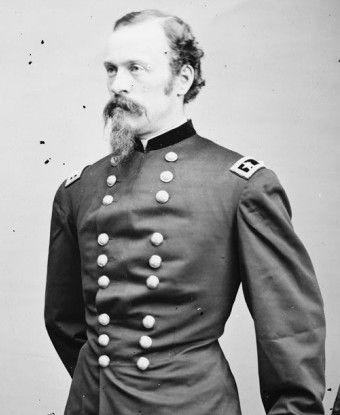Last updated: June 18, 2015
Person
James H. Wilson

Library of Congress's Prints and Photographs Division
A career U.S. Army officer and topographical engineer, James Harrison Wilson graduated from West Point near the top of his class in 1860. After the war the broke out, he served as topographical engineer for the Port Royal Expeditionary Force from September 1861 to March 1862. For his service at the Battle of Fort Pulaski, Wilson received a brevet promotion to major in the regular army. He then served as aide-de-camp to Major General George McClellan and topographical engineer to McClellan's Army of the Potomac from April 1862 through the Maryland Campaign. Wilson joined Major General Ulysses S. Grant's Army of the Tennessee, serving as topographical engineer and inspector general during the Vicksburg Campaign. After being promoted to brigadier general of volunteers, he became chief engineer under Major General William T. Sherman.
In early 1864, Wilson was assigned to lead the newly formed Cavalry Bureau in Washington, D.C. where he lobbied the War Department to equip the cavalry with fast-loading Spencer repeating carbines. Grant then promoted Wilson to brevet major general in May 1864, and assigned him to command Third Division in Major General Philip H. Sheridan's cavalry corps. He led his cavalry troops in both the Overland and Valley Campaigns of 1864. In October 1864, Grant promoted Wilson to major general of volunteers and assigned him to the Military Division of the Mississippi as commander of Sherman's cavalry corps.
In March 1865, Wilson led a force of 13,500 troops in an invasion of Alabama whose objective was the strategically important Confederate arsenal at Selma. In the largest, and arguably most successful, cavalry raid of the war, Wilson led his disciplined troops 300 miles in 12 days and defeated General Nathan Bedford Forrest's Confederate troops at Ebenezer Church, Alabama, on April 1, 1865, and then again at Selma two days later. His forces captured Montgomery, Alabama's capital, on April 12th, followed by Columbus, Georgia, on the 20th. Wilson's Raid resulted in the capture over 7,000 combatants and 300 cannon. On May 10, 1865, his troops also captured Confederate President Jefferson Davis, which earned Wilson a promotion to major general in the regular army.
After the war, Wilson reverted to the Regular Army rank of Lieutenant Colonel and was assigned to lead the 35th U.S. Infantry. He also managed engineering projects along the Mississippi River for the Army Corps of Engineers. After resigning from the Army in December 1870, Wilson worked as a railroad construction engineer and executive. In 1898, Wilson rejoined the Army, serving as a major general of volunteers in Puerto Rico and Cuba during the Spanish-American War. In 1900, he was sent to China to help suppress the Boxer Rebellion. The following year, Wilson retired with the rank of brigadier general in the Regular Army.
